Rich, Gooey Chocolate Cookies: Sargent Choice’s Remedy for Finals-Induced Stress and Icy Temperatures
By Kelli Swensen, Dietetics Student, Sargent College
With below-freezing temperatures and nose-numbing winds, I put down my human physiology textbook and layered up to make the trek to Stuvi2’s Sargent Choice Test Kitchen. With the tips of my ears cranberry red and frantically searching my pockets for a tissue, I made it into the elevator, pressed the round 23 button, and relaxed, knowing in a few short moments I would be enjoying a steaming hot cup of tea and eating fresh-out-of-the oven cookies.
Unknown to me until this year, the Sargent Choice Test Kitchen is held at Professor Karen Jacob’s beautiful Stuvi apartment every Wednesday night at 8:30. If you haven’t been to one of these nights: go! The name “Sargent Choice Test Kitchen” may be a bit intimidating to some, but trust me, it’s far from it. It is more of an extended family get-together over healthy food and hot tea – an essential part of the night. If you love to crack eggs, sift together flour, simmer onions and garlic, mince vegetables, or just have a passion for eating, you will love it here. And after the food? You can go back to studying or you can stay and socialize, even get everyone to compete in a hilarious game of Apples-to-Apples.
If you did decide to brave the cold Wednesday, you would’ve been rewarded with Sargent Choice Chocolate Chip Cherry Cookies. If you’re someone who isn’t always a fan of fruit in desserts, give this one a shot – trust me, it’ll surprise you how perfectly the chewy texture of the cherries combines with the gooeyness of the cookie.
To start, reconstitute 2/3 cup of cherries by soaking them in a bowl of hot water; this will add back some of their original moisture. On Wednesday, we did a mix of dried cherries and dried cranberries, which I highly recommend doing to add another level of sweetness to the cookies.

While the cherries and cranberries are soaking, combine 1 cup of whole white wheat flour, 1/3 cup of unsweetened cocoa powder, ½ tsp of baking powder, ¼ tsp of baking soda, and ¼ tsp of salt.

In another bowl, beat, on high speed, ¾ cup of granulated sugar and 1/3 cup of unsalted butter in a large bowl until creamy. I know ¾ cup of sugar may not sound like enough sugar but trust me you do not want to add any more! The best part about these cookies is the combination of deep, chocolaty taste with bursts of sweetness from the cherries and cranberries.
Add 1 tsp vanilla and 1 egg to butter mixture. Put the mixer on low speed and slowly add in the flour mixture. Our batter was pretty dry so we added a little more than 1 Tbs of water. If this happens to you, only add 1 Tbs of water to start, and then add in little amounts as needed. The batter is supposed to be quite sticky, so don’t add too much liquid.

The recipe says to drain cherries and fold them into the batter along with the 3 Tbs of semi-sweet mini chocolate chips; however, because our dough was a bit dry, we didn’t drain the cherries completely and poured some of that water into the batter.
Once the batter is sticky but not dry, make tablespoon-sized balls of dough and place each 2-inches apart onto baking sheets that have been covered with cooking spray. We found that the cookies come out best if you slightly flatten the dough, making small disks.

Once the baking sheets are ready to go, pop them in a 350-degree oven for about 12-15 min. The edges should look chewy and the middles still slightly doughy – don’t worry they will continue to cook a bit after you take them out of the oven. The recipe says to cool for 5 min, which for us was impossible, resulting in many burnt, but still satisfied, tongues. If you’re impatient like us, I do want to warn you that although the cookies may be wonderfully hot, the cherries and cranberries will be painfully hot.

So what do they taste like? The most accurate description is they are decadently rich, gooey brownies in cookie form. The cranberries and cherries in the recipe have a holiday feel to them, making this a perfect cookie to add to your holiday cookie platter. Remember to keep an eye out for next semester’s Test Kitchen Schedule! Happy Holidays!

Chocolate Chip Cherry Cookies
Makes 30 cookies
Preheat over to 350 degrees
Ingredients:
- 1 cup 100% whole white wheat flour
- 1/3 cup cocoa powder, unsweetened
- ½ tsp baking powder
- ¼ tsp baking soda
- ¼ tsp salt
- ¾ cup granulated sugar
- 1/3 cup unsalted butter
- 1 tsp vanilla extract
- 1 large egg
- 2/3 cup dried cherries (we did half dried cherries and half cranberries) + Hot water
- 3 Tbs semi-sweet mini chocolate chips or regular chocolate chips roughly chopped
Directions
1. Preheat the oven to 350
2. Measure out 2/3 cup dried cherries into a bowl and cover with hot water.
Let sit while mixing together other ingredients. (If using cranberries, soak
them with the cherries)
3. Lightly spoon flour into a dry measuring cup; level with a knife
4. Combine flour, cocoa, baking powder, baking soda, and salt, stirring with a
whisk.
5. Place sugar and butter in a large bowl; beat with a mixer at high speed
until well blended
6. Add vanilla and egg; beat well. With mixer on low speed, gradually add
flour mixture. Mix just until combined. If batter seems too thick or will not
stir together well, add 1 Tbs of water
7. Drain cherries and fold into batter with chocolate chips. (If your batter is
dry, you can opt to not completely drain the cherries and use some of that
water to moisten the dough)
8. Drop mixture by tablespoonfuls 2 inches apart onto baking sheets coated
with cooking spray. (It may help to flatten the dough into disks)
9. Bake at 350 for 12-15 minutes or just until set. Remove from oven; cool on
pans 5 minutes. Remove from pans; cool completely on wire racks.
Tip: In our recipe we use White Whole Wheat Flour instead of All Purpose Flour. Milled from white whole wheat, White Whole Wheat Flour has all the fiber and nutrition of traditional whole wheat, with milder flavor and lighter color. We find that in cookies, muffins, pancakes and quick breads, using white whole wheat flour in place of the entire amount of all-purpose flour yields a baked treat that's just as tasty as the original, with the benefit of increased fiber, vitamins and minerals. Our favorite brand is King Arthur's Flour. Try next time you bake!













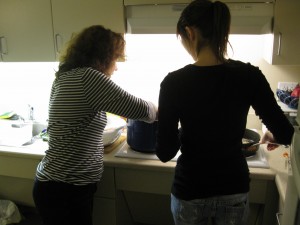

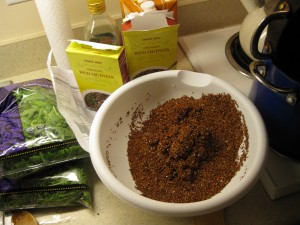

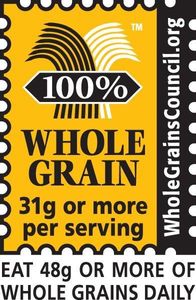


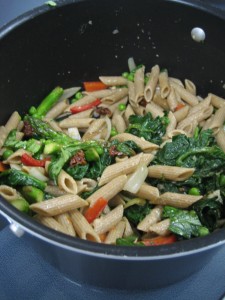
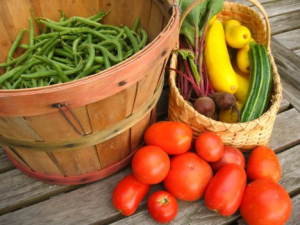

 photo credit: Elizabeth Jarrard
photo credit: Elizabeth Jarrard